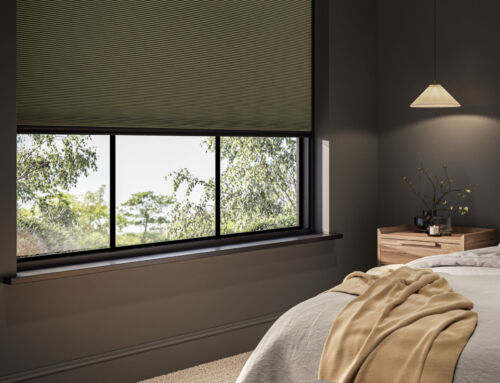The importance of energy efficiency within our homes has grown significantly in recent years, with homeowners increasingly seeking ways to reduce energy consumption, save on utility bills, and promote a sustainable lifestyle. In this quest for improved energy efficiency, the role of insulated window treatments cannot be overstated. High-quality blinds, curtains, and shutters can provide the much-needed insulation that helps to keep our living spaces comfortable throughout the year while reducing heat loss and energy wastage.
In this comprehensive guide, we’ll delve into the world of energy-efficient window treatments, exploring the various options available to Warwickshire homeowners. We will discuss the science behind insulated window treatments, as well as the best materials and designs to choose from to maximise energy savings. Our goal is to equip you with the knowledge and understanding needed to select the most effective and efficient window treatments for your Warwickshire home.
1. The Science behind Insulated Window Treatments: Understanding Heat Transfer
To truly appreciate the value of insulated window treatments, it’s essential to understand how they work – specifically, how they help to reduce heat transfer. In general, heat follows the flow of temperature, moving from warmer areas to cooler ones. This transfer occurs through three main processes: conduction, convection, and radiation.
Conduction refers to the movement of heat through solid materials, such as window glass. Convection involves heat circulating through air or liquids. Radiation is the transfer of heat through electromagnetic waves – such as the warmth you feel from the sun’s rays.
Insulated window treatments help to minimise heat loss through these processes by creating a barrier between the window and the room. This barrier reduces conduction, slows down convection, and reflects or absorbs radiant heat, ultimately helping to maintain a stable, comfortable indoor temperature.
2. Choosing the Right Insulated Blinds for Your Warwickshire Home
Insulated blinds come in various styles and materials, each possessing different insulating capabilities. Let’s examine some popular options to help you determine the best choice for your Warwickshire home:
– Cellular Shades: Comprising a unique honeycomb design, cellular shades effectively trap air within their individual cells. This creates an insulating layer that can significantly reduce heat transfer, making them an excellent option for energy-efficient window treatments.
– Roman Blinds: Combining style with functionality, Roman blinds with insulated lining can offer superior thermal performance. This lining, usually made of a reflective material, aids in controlling room temperature by reflecting heat back into the room during winter and repelling it during summer.
– Vertical Blinds: When crafted with energy-efficient materials such as PVC or blackout fabric, vertical blinds can provide insulation against heat transfer. However, due to their design, they may offer inferior thermal efficiency compared to other styles.
3. Enhancing Energy Efficiency with Insulated Curtains
Insulated curtains offer another effective solution for promoting energy efficiency within your home. Pay close attention to the following features to maximise their insulating capabilities:
– Thermal Lining: A specialised lining can significantly boost the thermal performance of your curtains. Options such as blackout linings or reflective linings not only enhance insulation but can also provide improved light control and privacy.
– Fabric Thickness and Weight: Generally, a thicker and heavier fabric will provide more effective insulation. Opting for densely woven fabrics like velvet, brocade or wool can help to reduce heat transfer through your windows.
– Fullness and Coverage: To maximise energy efficiency, ensure your curtains are wide enough to cover the entire window, as well as a considerable portion of the surrounding wall area. Additionally, providing ample fullness (ideally two to three times the width of the window) can prevent heat from escaping through gaps or folds in the fabric.
4. Maximising Insulation with Shutters
Shutters serve as stylish and timeless window treatment solutions, and their innate design features contribute to their superb energy efficiency. To further enhance their insulation capabilities, consider the following:
– Material Selection: Solid wood shutters offer excellent insulating properties due to their density and natural ability to slow down heat transfer. Composite or faux wood options can also provide effective insulation, but they may be more susceptible to issues such as warping or swelling in extreme temperatures.
– Style and Fit: Opting for full-height shutters or tier-on-tier designs can provide more comprehensive coverage for your windows, which can lead to improved insulation. Ensure your shutters are custom-fit to your windows to minimise gaps that may compromise their thermal efficiency.
– Additional Insulation: Applying weatherstripping or adhesive insulation tape around the edges of your shutter frames can help seal gaps and further mitigate heat transfer.
Elevate Your Warwickshire Home’s Energy Efficiency with Insulated Window Treatments
Upgrading your window treatments to insulated blinds, curtains, or shutters can yield remarkable improvements in your home’s energy efficiency and overall comfort. With an array of styles, materials, and designs available, Warwickshire homeowners can select a solution that caters to their thermal needs and complements their unique taste.
As a leading blinds supplier in Nuneaton, Shady Blinds offers top-quality insulated window treatments crafted to meet and exceed our clients’ expectations. Contact us today to discuss your energy efficiency goals, browse our impressive range of bespoke products, and embark on the journey towards a more environmentally friendly and cost-effective home.






Leave A Comment